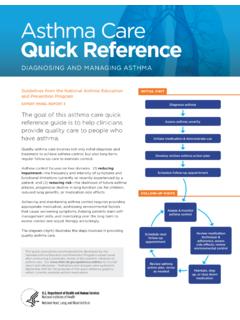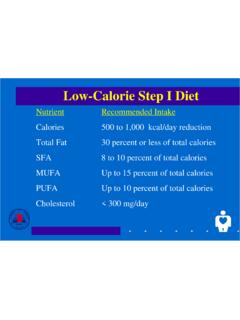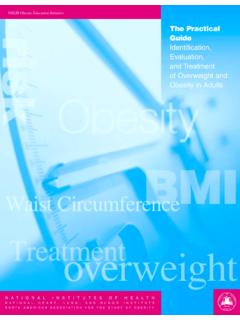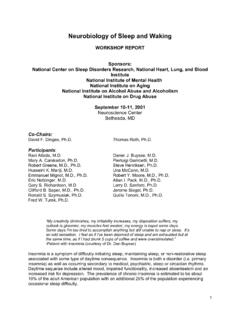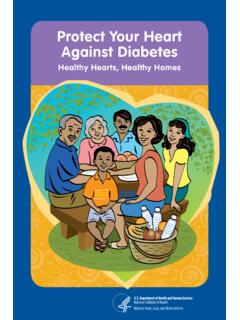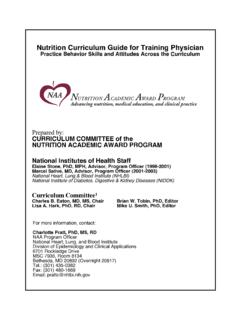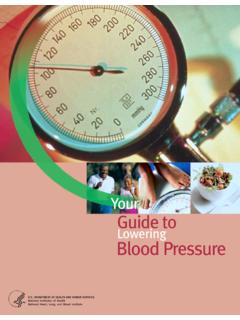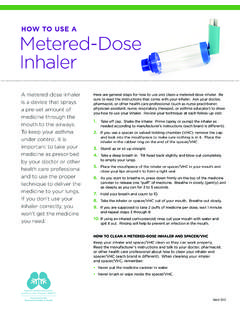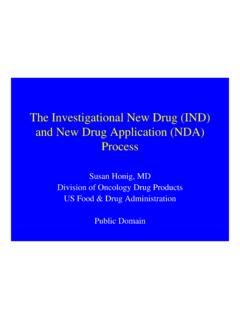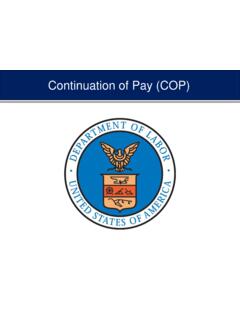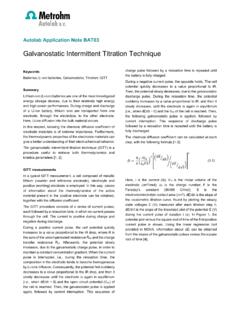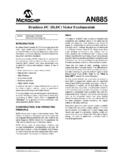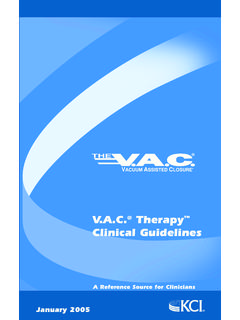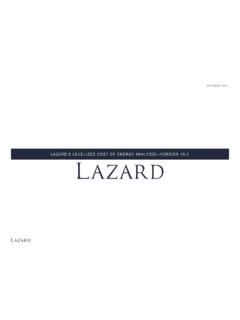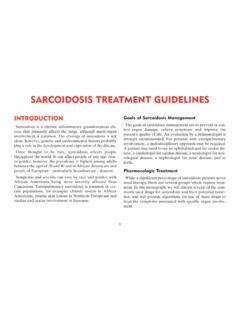Transcription of 2020 Focused Updates to the Asthma Management …
1 2020 Focused Updates TO THE Asthma Management Guidelines CLINICIAN S GUIDE PURPOSEThis Clinician s Guide summarizes the 2020 Focused Updates to the Asthma Management Guidelines: A Report from the National Asthma Education and Prevention Program Coordinating Committee Expert Panel Working Group to help clinicians integrate the new recommendations into clinical care. The full 2020 Report, which is Focused on selected topics rather than a complete revision of the 2007 Expert Panel Report 3: Guidelines for the Diagnosis and Management of Asthma (EPR-3), can be found at This summary guide should be used in conjunction with the full report. The Guide is organized by the following topics: intermittent Inhaled CorticosteroidsLong-Acting Muscarinic AntagonistsIndoor Allergen MitigationImmunotherapy in the Treatment of Allergic AsthmaFractional Exhaled Nitric Oxide TestingBronchial ThermoplastyMultiple stakeholders contributed to the selection of topics for the update.
2 The Agency for Healthcare Research and Quality s (AHRQ) Evidence-Based Practice Centers conducted systematic reviews on these topics, which were subsequently published and used by the Expert Panel Working Group (the Expert Panel) of the National Asthma Education and Prevention Program Coordinating Committee (NAEPPCC), coordinated by the National Heart, Lung, and Blood Institute, as a basis for the Updates . The Expert Panel used GRADE (Grading of Recommendations Assessment, Development, and Evaluation), an internationally accepted framework, for determining the certainty of evidence and the direction and strength of recommendations based on the evidence. Each recommendation is described as either strong or conditional. For all recommendations, shared decision making should be used to help individuals with Asthma make choices that are consistent with their risks, values, and preferences; this is especially important for conditional showing the recommended approaches to care, including the new recommendations, for individuals with Asthma based on age have been updated from EPR-3.
3 Within a given step, the preferred options are the best Management choices supported by the evidence reviewed by the Expert Panel. When the available evidence was insufficient or did not change a previous recommendation, the diagrams list the preferred options from EPR-3. The diagrams are meant to assist, and not replace, clinical judgment or decision making required for individual patient Management with input from individuals with Asthma about their Publication No. 20-HL-8141 December 2020 CLINICIAN S GUIDE 2020 Focused Updates TO THE Asthma Management Guidelines2 intermittent INHALED CORTICOSTEROIDSS cheduled, daily inhaled corticosteroid (ICS) treatment is the currently preferred pharmacologic controller therapy for persistent Asthma in individuals of all ages. intermittent ICS dosing includes courses of ICS treatment used for brief periods, usually in response to symptoms or as an add-on with or without a long-acting beta2-agonist (LABA).
4 Recommendations for ICS treatment are organized by age. Children Ages 0 4 Years with Recurrent Wheezing KEY POINTIn children ages 0 4 years with recurrent wheezing, a short (7 10 day) course of daily ICS with as-needed inhaled short-acting beta2-agonist (SABA) for quick-relief therapy is recommended starting at the onset of a respiratory tract GUIDANCE AND CONSIDERATIONS FOR SHARED DECISION-MAKING Target population: Children ages 0 4 years with recurrent wheezing (at least three episodes of wheezing triggered by apparent infection in their lifetime or two episodes in the past year with no symptoms between infections) and who are not taking daily Asthma treatment. Treatment: One regimen used in two reviewed studies is budesonide inhalation suspension, 1 mg twice daily for 7 days at the first sign of respiratory tract infection-associated symptoms. Potential benefits: The main benefit during respiratory tract infections is a reduction in exacerbations requiring systemic corticosteroids.
5 Potential risks: This treatment could affect growth. Carefully monitor growth in children who use this treatment. Other considerations: Caregivers can initiate intermittent ICS treatment at home without a visit to a health care provider when they have clear children ages 0 4 years with recurrent wheezing triggered by respiratory tract infections and no wheezing between infections, the Expert Panel conditionally recommends starting a short course of daily ICS at the onset of a respiratory tract infection with as-needed SABA for quick-relief therapy compared to as-needed SABA for quick-relief therapy only. CLINICIAN S GUIDE 2020 Focused Updates TO THE Asthma Management Guidelines3 Individuals Ages 4 Years and Older with Persistent AsthmaKEY POINTS For individuals with mild to moderate persistent Asthma who are taking daily ICS treatment (likely adherent with prescribed daily ICS) as a controller, increasing the regular daily ICS dose for short periods is not recommended when symptoms increase or peak flow decreases.
6 For individuals with moderate to severe persistent Asthma already taking low- or medium-dose ICS, the preferred treatment is a single inhaler with ICS-formoterol (referred to as single maintenance and reliever therapy, or SMART ) used both daily and as Ages 12 Years and Older with Persistent Asthma KEY POINTS For individuals with mild persistent Asthma , either of the following two treatments are recommended as part of Step 2 therapy: 1) a daily low-dose ICS and as-needed SABA for quick-relief therapy, or 2) intermittent as-needed SABA and ICS used one after the other for worsening approach to intermittent therapy is 2 4 puffs of albuterol followed by 80 250 mcg of beclomethasone equivalent every 4 hours as needed for Asthma symptoms. 9 intermittent therapy can be initiated at home with regular provider follow-up to ensure that the intermittent regimen is still with either low or high perception of symptoms may not be good candidates for as-needed ICS therapy.
7 Daily low-dose ICS with as-needed SABA may be preferred. For individuals with moderate to severe persistent Asthma already taking low- or medium-dose ICS, the preferred treatment is a single inhaler with ICS-formoterol (referred to as single maintenance and reliever therapy, or SMART ) used both daily and as needed. RECOMMENDATIONS (AGES 4+) In individuals ages 4 years and older with mild to moderate persistent Asthma who are likely to be adherent to daily ICS treatment, the Expert Panel conditionally recommends against a short-term increase in the ICS dose for increased symptoms or decreased peak flow. In individuals ages 4 years and older with moderate to severe persistent Asthma , the Expert Panel recommends ICS-formoterol in a single inhaler used as both daily controller and reliever therapy compared to either a higher-dose ICS as daily controller therapy and SABA for quick-relief therapy or the same-dose ICS-LABA as daily controller therapy and SABA for quick-relief therapy.
8 RECOMMENDATIONS (AGES 12+) In individuals ages 12 years and older with mild persistent Asthma , the Expert Panel conditionally recommends either daily low-dose ICS and as-needed SABA for quick-relief therapy or as-needed ICS and SABA used concomitantly. In individuals ages 12 years and older with moderate to severe persistent Asthma , the Expert Panel conditionally recommends ICS-formoterol in a single inhaler used as both daily controller and reliever therapy compared to higher-dose ICS-LABA as daily controller therapy and SABA for quick-relief therapy. CLINICIAN S GUIDE 2020 Focused Updates TO THE Asthma Management Guidelines4 SINGLE MAINTENANCE AND RELIEVER THERAPY (SMART) IMPLEMENTATION GUIDANCE AND CONSIDERATIONS FOR SHARED DECISION MAKING Target population: Individuals 4 years and older with a severe exacerbation in the prior year are particularly good candidates for SMART to reduce exacerbations.
9 Who should not receive this treatment: Do not use ICS-formoterol as reliever therapy in individuals taking ICS-salmeterol as maintenance therapy. Treatment: Inhaled ICS-formoterol in a single inhaler. This form of therapy has only been studied with formoterol as the long-acting beta2-agonist (LABA). 9 SMART is appropriate for Step 3 (low-dose ICS) and Step 4 (medium-dose ICS) whose Asthma is uncontrolled on maintenance ICS-LABA with SABA as quick-relief therapy should receive the preferred SMART if possible before moving to a higher step of should be administered as maintenance therapy with 1 2 puffs once or twice daily (depending on age, Asthma severity, and ICS dose in the ICS-formoterol preparation) and 1 2 puffs as needed for Asthma symptoms. 9 Maximum number of puffs per day is 8 (36 mcg formoterol) for children ages 4 11 years and 12 (54 mcg formoterol) for individuals ages 12 years and individuals to contact their physician if they need to exceed maximum number of of formoterol was based on mcg/inhalation, the most common preparation used in the studies reviewed.
10 Potential benefits: In studies this treatment consistently reduced Asthma exacerbations requiring unscheduled medical visits or systemic corticosteroids and in some studies improved Asthma control and quality of life. Reduced exposure to oral corticosteroids and to ICS treatment suggest that the intervention might reduce future corticosteroid-associated harms. Potential risks: Studies found no difference in documented harms between this type of therapy and daily ICS, or ICS-LABA, with SABA as quick relief therapy. Other considerations: 9In children ages 4 11 years, there may be a lower risk of growth suppression among those taking SMART versus daily higher-dose ICS recommendation might not be appropriate for some individuals with Asthma because of cost, formulary considerations, or medication intolerance. 9A 1-month supply of ICS-formoterol medication that is sufficient for maintenance therapy may not last a month if the inhaler is used for reliever therapy as S GUIDE 2020 Focused Updates TO THE Asthma Management Guidelines5 LONG-ACTING MUSCARINIC ANTAGONISTSLong-acting muscarinic antagonists (LAMAs)* comprise a pharmacologic class of long-acting bronchodilators.
